Application of U-FAST Technology in Sintering of Submicron WC-Co Carbides
Abstract
1. Introduction
2. Experimental Procedure
3. Characterization of Starting Material
4. Results and Discussion
5. Conclusions
Author Contributions
Funding
Institutional Review Board Statement
Informed Consent Statement
Data Availability Statement
Conflicts of Interest
References
- Buravleva, A.A.; Fedorets, A.N.; Vornovskikh, A.A.; Ognev, A.V.; Nepomnyushchaya, V.A.; Sakhnevich, V.N.; Lembikov, A.O.; Kornakova, Z.E.; Kapustina, O.V.; Tarabanova, A.E.; et al. Spark Plasma Sintering of WC-Based 10wt%Co Hard Alloy: A Study of Sintering Kinetics and Solid-Phase Processes. Materials 2022, 15, 1091. [Google Scholar] [CrossRef] [PubMed]
- Wachowicz, J.; Dembiczak, T.; Stradomski, G.; Bałaga, Z.; Dyner, M.; Wilkowski, J. Properties of WCCo Composites Produced by the SPS Method Intended for Cutting Tools for Machining of Wood-Based Materials. Materials 2021, 14, 2618. [Google Scholar] [CrossRef] [PubMed]
- Qian, Y.; Zhao, Z. Microstructure and Properties of Ultrafine Cemented Carbides Prepared by Microwave Sintering of Nanocomposites. Crystals 2020, 10, 507. [Google Scholar] [CrossRef]
- Wang, Z.; Jia, J.; Wang, B.; Wang, Y. Two-Step Spark Plasma Sintering Process of Ultrafine Grained WC-12Co-0.2VC Cemented Carbide. Materials 2019, 12, 2443. [Google Scholar] [CrossRef]
- Dobrzański, L.A. Podstawy Nauki o Materiałach i Metaloznawstwo—Materiały Inżynierskie z Podstawami Projektowania Materiałowego; Wydawnictwa Naukowo—Techniczne: Warszawa, Poland, 2002. [Google Scholar]
- Yang, Y.; Zhang, C.; Wang, D.; Nie, L.; Wellmann, D.; Tian, Y. Additive manufacturing of WC-Co hardmetals: A review. Int. J. Adv. Manuf. Technol. 2020, 108, 1653–1673. [Google Scholar] [CrossRef]
- Yang, X.H.; Wang, K.F.; Zhang, G.H.; Chou, K.C. Fabrication and performances of WC-Co cemented carbide with a low cobalt content. Int. J. Appl. Ceram. Technol. 2022, 19, 1341–1353. [Google Scholar] [CrossRef]
- Bouleghlem, M.; Zahzouh, M.; Hamidouche, M.; Boukhobza, A.; Fellah, M. Microstructural and Mechanical Investigation of WC-TiC-Co Cemented Carbides Obtained by Conventional Powder Metallurgy. Int. J. Eng. Res. Afr. 2019, 45, 1–14. [Google Scholar] [CrossRef]
- Weidow, J.; Johansson, S.; Andrén, H.O.; Wahnström, G. Transition metal solubilities in WC in cemented carbide materials. J. Am. Ceram. Soc. 2011, 94, 605–610. [Google Scholar] [CrossRef]
- García, J.; Ciprés, V.C.; Blomqvist, A.; Kaplan, B. Cemented carbide microstructures: A review. Int. J. Refract. Met. Hard Mater. 2018, 80, 40–68. [Google Scholar] [CrossRef]
- Ke, Z.; Zheng, Y.; Zhang, G.; Qingjun, D.; Zhang, J.; Wu, H.; Xu, X.; Lu, X.; Zhu, X. Microstructure and mechanical properties of dual-grain structured WC-Co cemented carbides. Ceram. Int. 2019, 45, 21528–21533. [Google Scholar] [CrossRef]
- Jucan, O.D.; Gădălean, R.V.; Chicinaş, H.F.; Hering, M.; Bâlc, N.; Popa, C.O. Study on the indirect selective laser sintering (SLS) of WC-Co/PA12 powders for the manufacturing of cemented carbide parts. Int. J. Refract. Met. Hard Mater. 2021, 96, 105498. [Google Scholar] [CrossRef]
- Kim, K.W.; Ham, G.S.; Park, S.H.; Cho, J.W.; Lee, K.A. Direct energy deposition of ultrastrong WC-12Co cemented carbide: Fabrication, microstructure and compressive properties. Int. J. Refract. Met. Hard Mater. 2021, 99, 105591. [Google Scholar] [CrossRef]
- Lee, S.W.; Kim, Y.W.; Jang, K.-M.; Lee, J.W.; Park, M.S.; Koo, H.Y.; Ha, G.; Kang, Y.C. Phase control of WC–Co hardmetal using additive manufacturing technologies. Powder Metall. 2022, 65, 13–21. [Google Scholar] [CrossRef]
- Eso, O.; Fang, Z.; Griffo, A. Liquid phase sintering of functionally graded WC–Co composites. Int. J. Refract. Met. Hard Mater. 2005, 23, 233–241. [Google Scholar] [CrossRef]
- Gu, L.; Huang, J.; Tang, Y.; Xie, C.; Gao, S. Influence of different post treatments on microstructure and properties of WC-Co cemented carbides. J. Alloys Compd. 2015, 620, 116–119. [Google Scholar] [CrossRef]
- Guillon, O.; Gonzalez-Julian, J.; Dargatz, B.; Kessel, T.; Schierning, G.; Räthel, J.; Herrmann, M. Field-assisted sintering technology/spark plasma sintering: Mechanisms, materials, and technology developments. Adv. Eng. Mater. 2014, 16, 830–849. [Google Scholar] [CrossRef]
- Hungria, T.; Galy, J.; Castro, A. Spark plasma sintering as a useful technique to the nanostructuration of piezo-ferroelectric materials. Adv. Eng. Mater. 2009, 11, 615–631. [Google Scholar] [CrossRef]
- Matizamhuka, W.R. Spark plasma sintering (SPS)—An advanced sintering technique for structural nanocomposite materials. J. S. Afr. Inst. Min. Metall. 2016, 116, 1171–1180. [Google Scholar] [CrossRef]
- Tokita, M. Progress of Spark Plasma Sintering (SPS) Method, Systems, Ceramics Applications and Industrialization. Ceramics 2021, 4, 160–198. [Google Scholar] [CrossRef]
- Cavaliere, P.; Sadeghi, B.; Shabani, A. Spark plasma sintering: Process fundamentals. In Spark Plasma Sintering of Materials; Springer: Cham, Switzerland, 2019; pp. 3–20. [Google Scholar]
- Hu, Z.Y.; Zhang, Z.H.; Cheng, X.W.; Wang, F.C.; Zhang, Y.F.; Li, S.L. A review of multi-physical fields induced phenomena and effects in spark plasma sintering: Fundamentals and applications. Mater. Des. 2020, 191, 108662. [Google Scholar] [CrossRef]
- Nygren, M.; Shen, Z. Spark plasma sintering: Possibilities and limitations. Key Eng. Mater. 2004, 264, 719–724. [Google Scholar] [CrossRef]
- Sovizi, S.; Seraji, M.E. The densification behavior of metals and alloys during spark plasma sintering: A mini-review. Sci. Sinter. 2019, 51, 135–152. [Google Scholar] [CrossRef]
- Jach, K.; Figiel, P.; Biedunkiewicz, A. Application of U-FAST Technology in Sintering of Titanium Biomaterials. Biomed. J. Sci. Tech. Res. 2019, 23, 17441–17444. [Google Scholar]
- Jach, K.; Rosiński, M. Przeświecalna ceramika z tlenku glinu wytworzona w technologii U-FAST. Mater. Ceram. Ceram. Mater. 2018, 70, 293–300. [Google Scholar]
- Available online: https://genicore.eu/products/devices/ (accessed on 20 January 2023).
- Sheikh, S.; M’Saoubi, R.; Flasar, P.; Schwind, M.; Persson, T.; Yang, J.; Llanes, L. Fracture toughness of cemented carbides: Testing method and microstructural effects. Int. J. Refract. Met. Hard Mater. 2015, 49, 153–160. [Google Scholar] [CrossRef]
- Lin, N.; He, Y.; Wu, C.; Zhang, Q.; Zou, J.; Zhao, Z. Fabrication of tungsten carbide–vanadium carbide core–shell structure powders and their application as an inhibitor for the sintering of cemented carbides. Scr. Mater. 2012, 67, 826–829. [Google Scholar] [CrossRef]
- Wei, C.; Song, X.; Zhao, S.; Zhang, L.; Liu, W. In-situ synthesis of WC–Co composite powder and densification by sinter-HIP. Int. J. Refract. Met. Hard Mater. 2010, 28, 567–571. [Google Scholar] [CrossRef]
- Zhao, S.; Song, X.; Wei, C.; Zhang, L.; Liu, X.; Zhang, J. Effects of WC particle size on densification and properties of spark plasma sintered WC–Co cermet. Int. J. Refract. Met. Hard Mater. 2009, 27, 1014–1018. [Google Scholar] [CrossRef]
- Liu, C.; Lin, N.; He, Y.; Wu, C.; Jiang, Y. The effects of micron WC contents on the microstructure and mechanical properties of ultrafine WC–(micron WC–Co) cemented carbides. J. Alloys Compd. 2014, 594, 76–81. [Google Scholar] [CrossRef]
- Wittmann, B.; Schubert, W.D.; Lux, B. WC grain growth and grain growth inhibition in nickel and iron binder hardmetals. Int. J. Refract. Met. Hard Mater. 2002, 20, 51–60. [Google Scholar] [CrossRef]
- Liu, K.; Wang, Z.; Yin, Z.; Cao, L.; Yuan, J. Effect of Co content on microstructure and mechanical properties of ultrafine grained WC-Co cemented carbide sintered by spark plasma sintering. Ceram. Int. 2018, 44, 18711–18718. [Google Scholar] [CrossRef]
- Konyashin, I.; Hlawatschek, S.; Ries, B.; Lachmann, F.; Dorn, F.; Sologubenko, A.; Weirich, T. On the mechanism of WC coarsening in WC–Co hardmetals with various carbon contents. Int. J. Refract. Met. Hard Mater. 2009, 27, 234–243. [Google Scholar] [CrossRef]
- Xu, C.; Ai, X.; Huang, C. Research and development of rare-earth cemented carbides. Int. J. Refract. Met. Hard Mater. 2001, 19, 159–168. [Google Scholar] [CrossRef]
- Azem, S.; Grosbras, M.; Yefsah, S. Effect of carbon content on the reactive sintering of mixed W-Co-C powders. Metall. Res. Technol. 2004, 101, 419–425. [Google Scholar] [CrossRef]
- Kitamura, K.; Kobayashi, M.; Hayashi, K. Microstructural development and properties of new WC-Co base hardmetal prepared from CoxWyCz+ C lnstead of WC. J. Jpn. Soc. Powder Powder Metall. 2001, 48, 621–628. [Google Scholar] [CrossRef]
- Deng, X.C.; Wang, K.F.; Zhang, G.H. Effects of oxide addition on structure and properties of WC–10Co cemented carbide obtained by in situ synthesized powder. Int. J. Appl. Ceram. Technol. 2022, 19, 1916–1928. [Google Scholar] [CrossRef]
- Aleksandrov Fabijanić, T.; Ćorić, D.; Šnajdar Musa, M.; Sakoman, M. Vickers Indentation Fracture Toughness of Near-Nano and Nanostructured WC-Co Cemented Carbides. Metals 2017, 7, 143. [Google Scholar] [CrossRef]
- Ferreira, J.A.M.; Amaral, M.P.; Antunes, F.V.; Costa, J.D.M. A study on the mechanical behaviour of WC/Co hardmetals. Int. J. Refract. Met. Hard Mater. 2009, 27, 1–8. [Google Scholar] [CrossRef]
- Fang, Z.Z.; Wang, X.; Ryu, T.; Hwang, K.S.; Sohn, H.Y. Synthesis, sintering, and mechanical properties of nanocrystalline cemented tungsten carbide—A review. Int. J. Refract. Met. Hard Mater. 2009, 27, 288–299. [Google Scholar] [CrossRef]
- Seegopaul, P.; Fang, Z.Z. Tungsten Carbide–Cobalt Nanocomposites. In Dekker Encyclopedia of Nanoscience and Nanotechnology, 3rd ed.; CRC Press: Boca Raton, FL, USA, 2014; pp. 5002–5010. [Google Scholar]
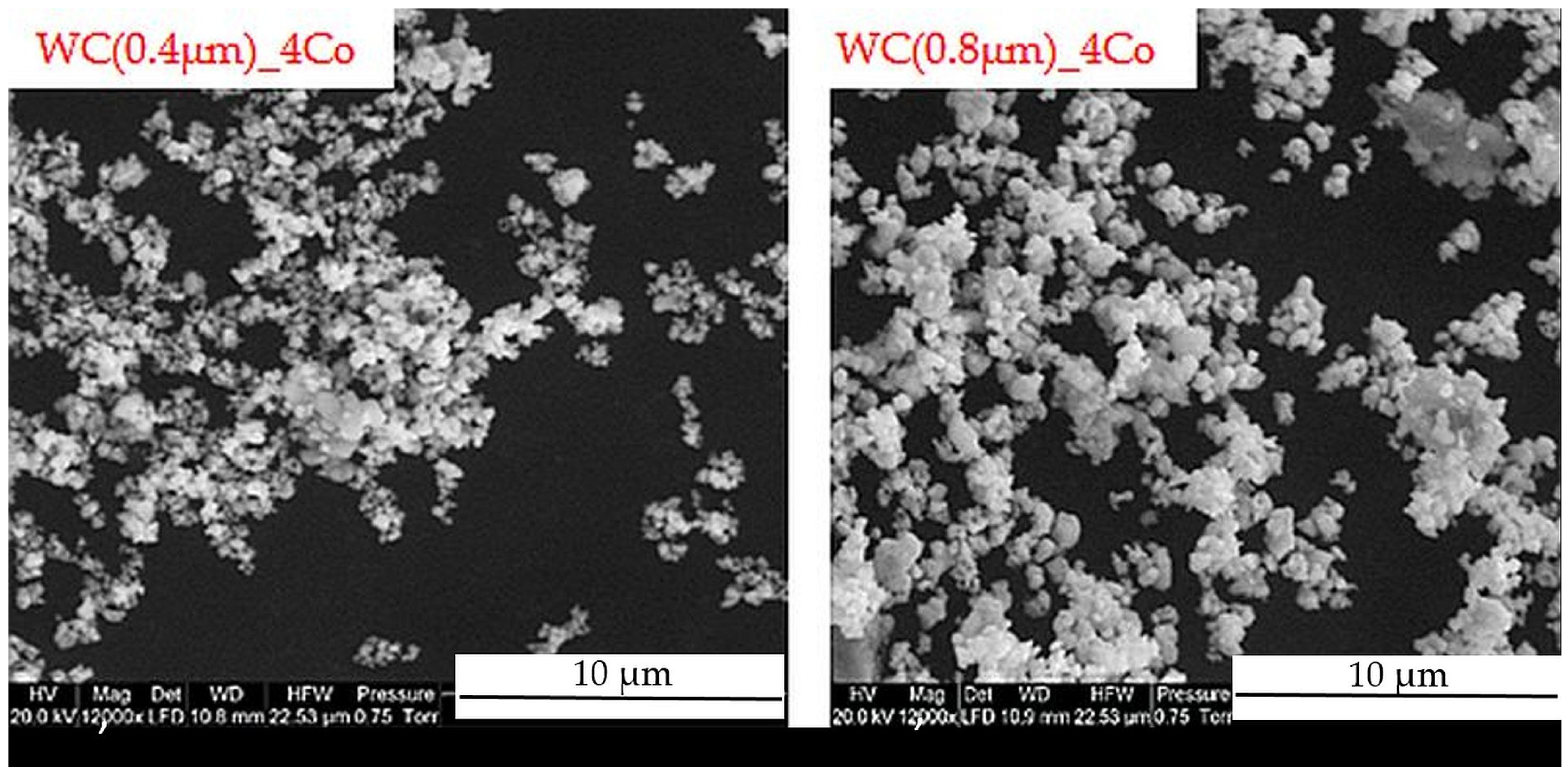
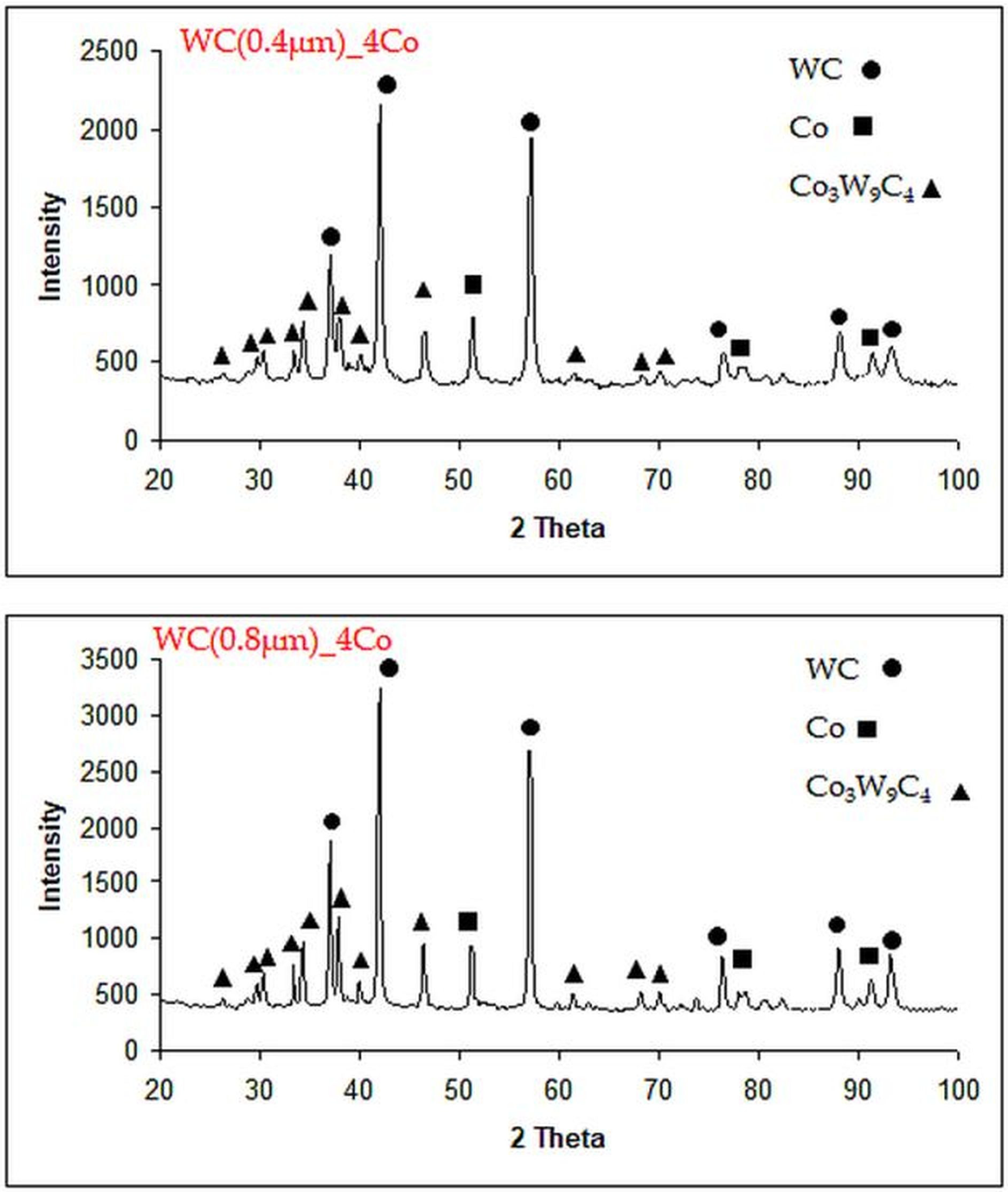
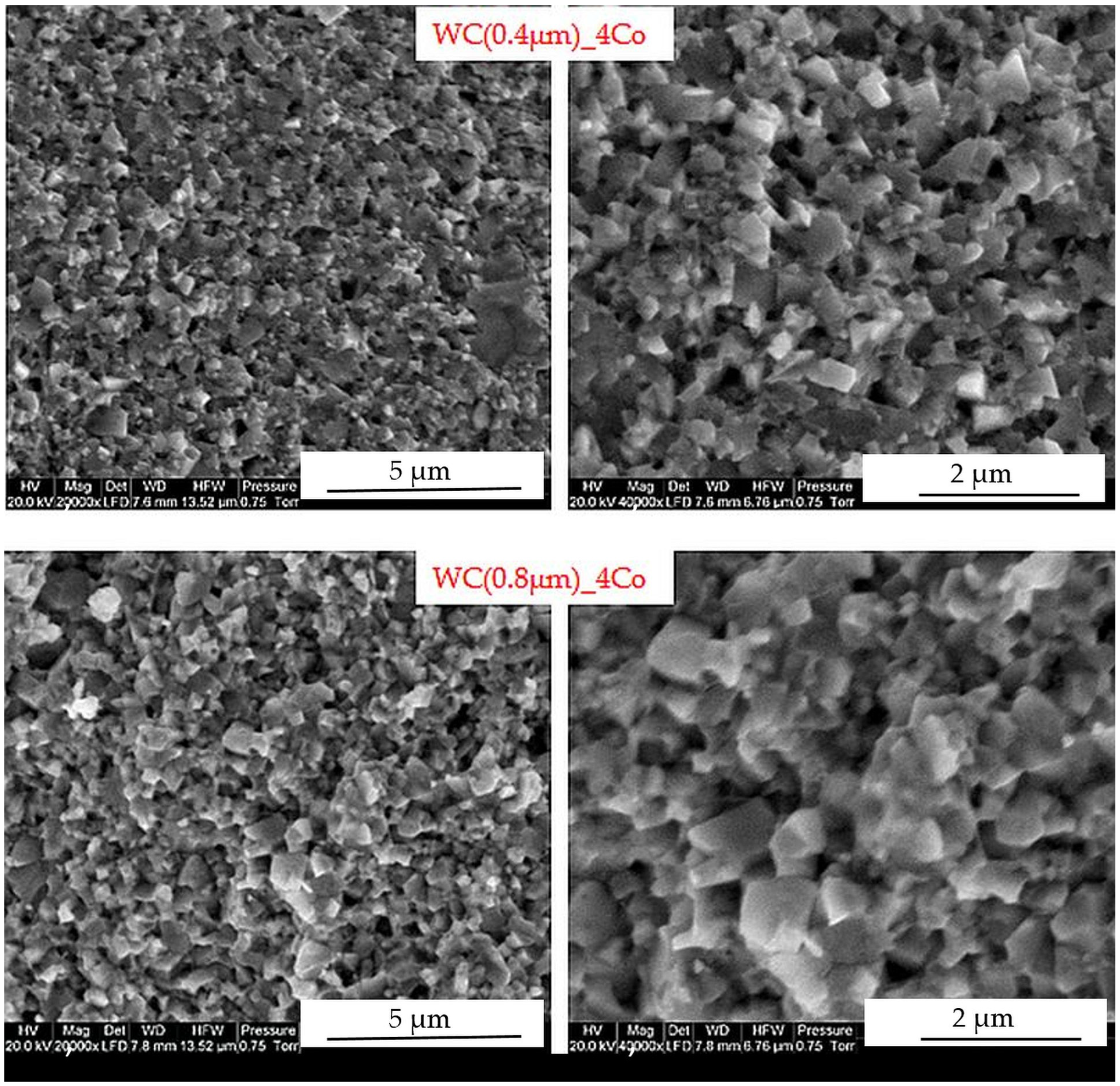
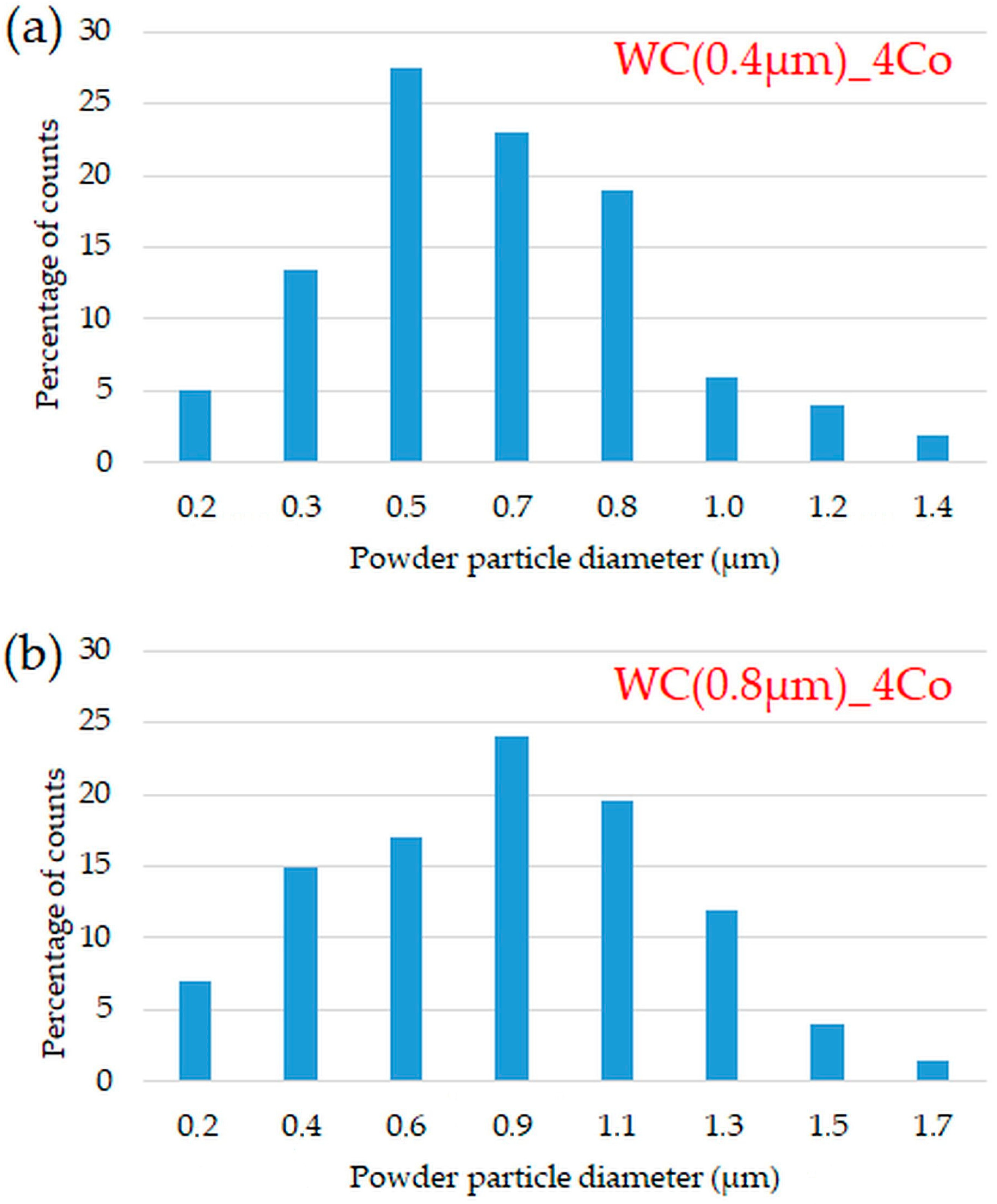
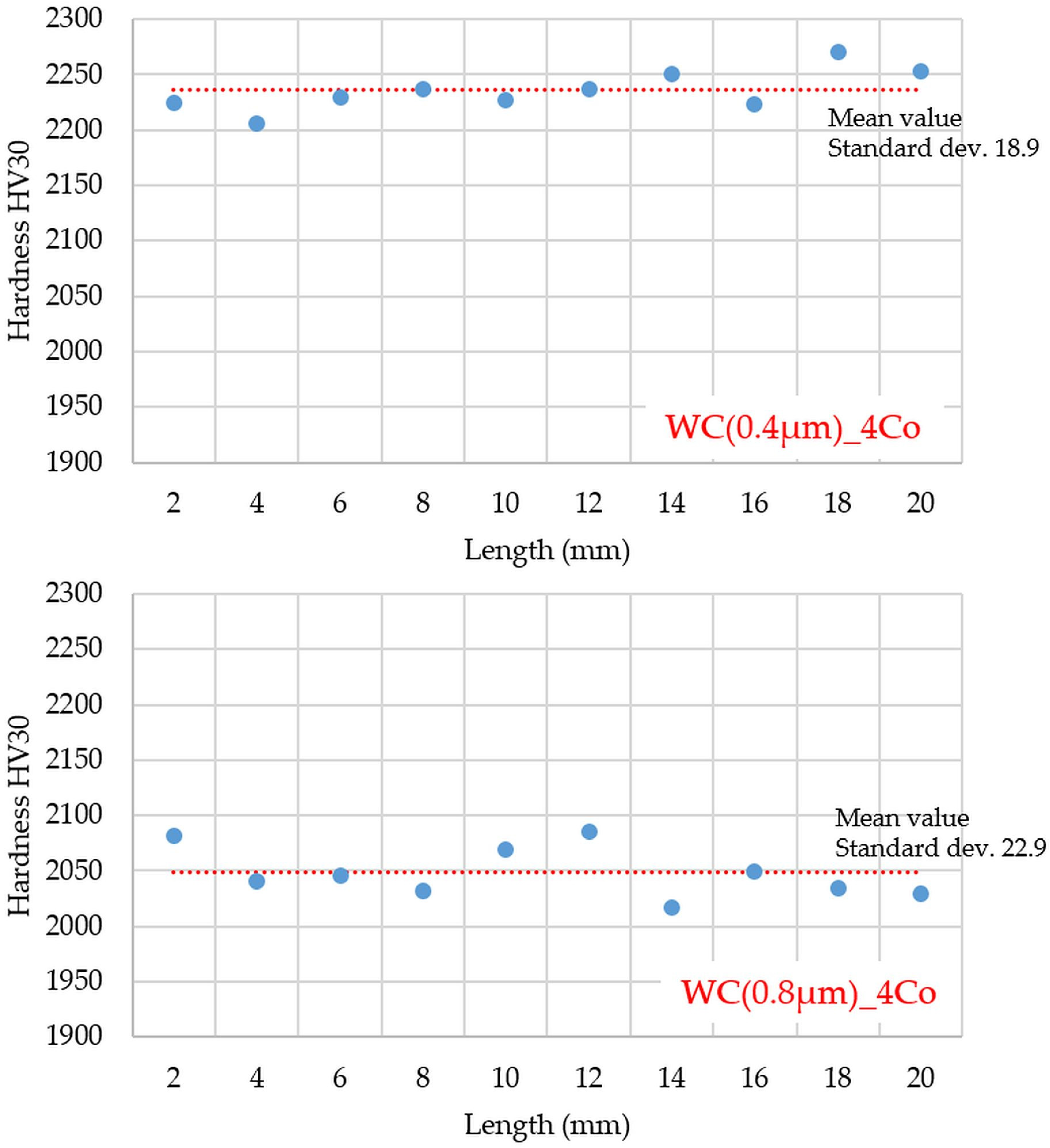
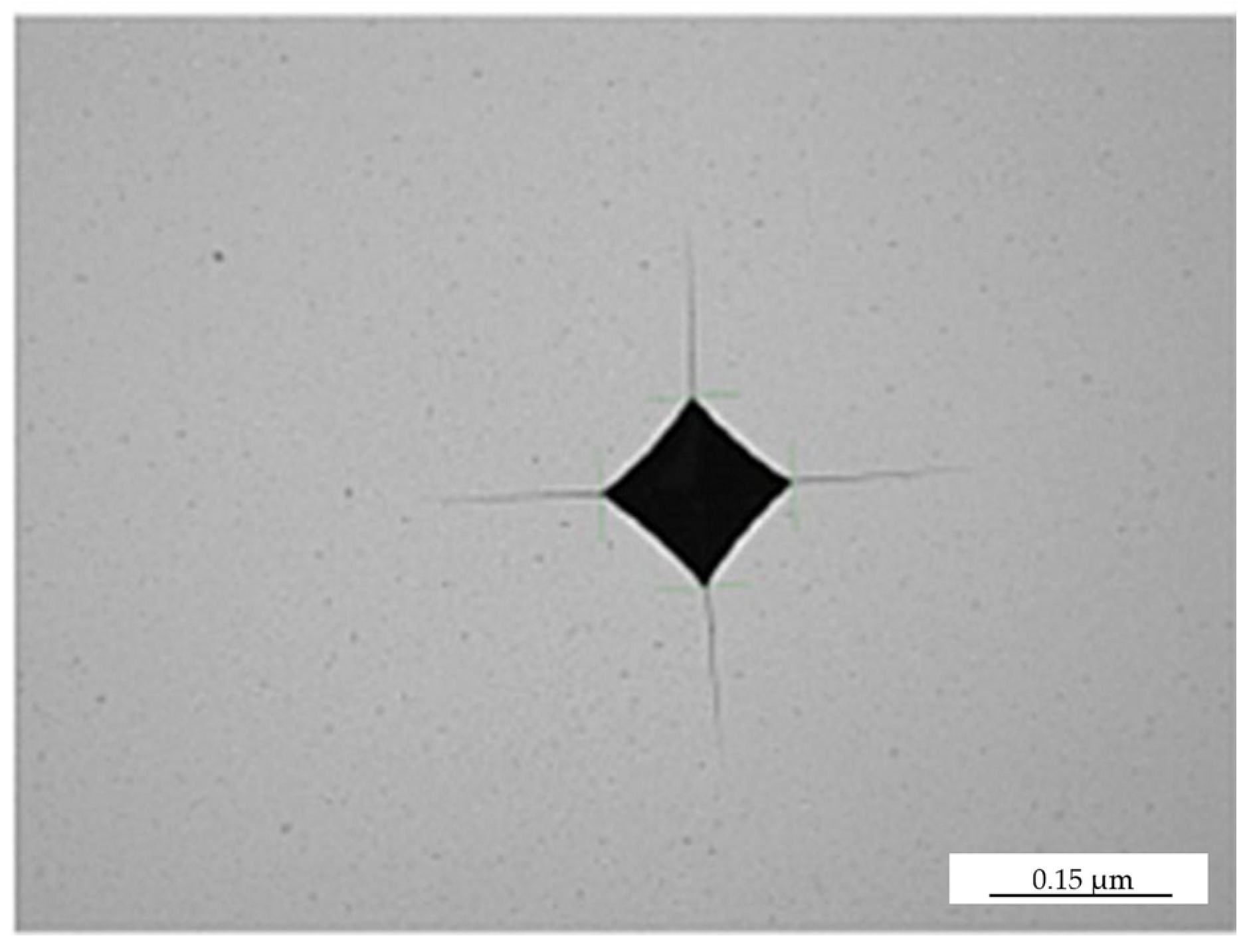
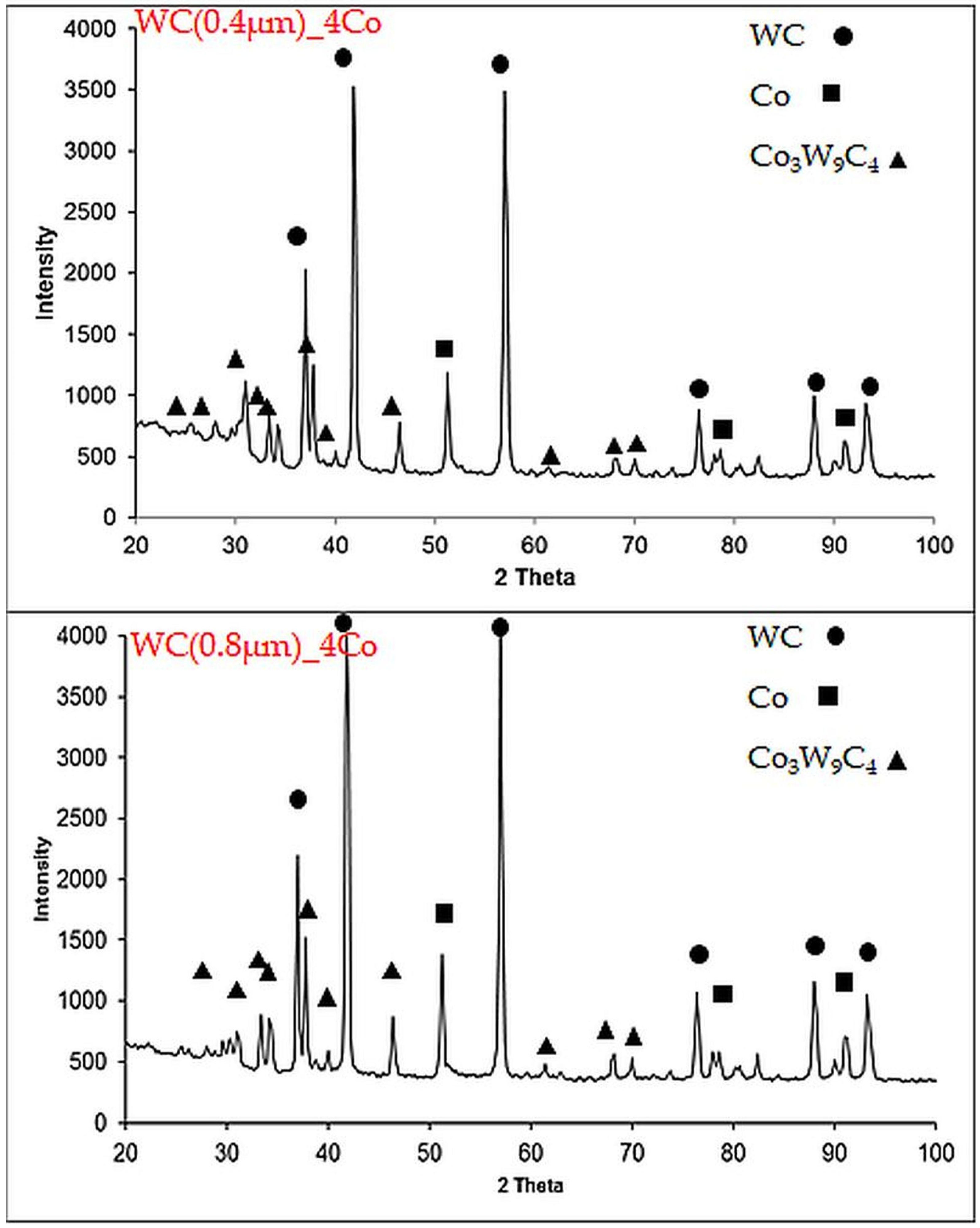
| Max. pulse current (kA) | 10 |
| Max. output voltage (V) | 14 |
| Pulse duration (ms) | 0.8–500 |
| Temperature measurements (°C) | 0–2500 |
| Vacuum (mbar) | 10−2–10−6 |
| Max. pressing force (kN) | 350 |
| Max. sintered components | Ø 85 |
| Max. diameter of graphite die (mm) | 200 |
| Additional pause (ms) | 0–999 |
| Number of pulses | 1–500 |
| Powder | Carbon wt% | Copper wt% | Iron wt% | Nickel wt% | Oxygen wt% | Silver wt% | Sulfur wt% |
|---|---|---|---|---|---|---|---|
| Cobalt | 0.15 | 0.0050 | 0.020 | 0.30 | 0.60 | 0.0030 | 0.010 |
| Property | 0.4 µm WC | 0.8 µm WC |
|---|---|---|
| Total C (wt%) | 6.16 | 6.15 |
| Free C (wt%) | <0.08 | 0.03 |
| Al (ppm) | 50 | <10 |
| Ca (ppm) | 50 | 1 |
| Cr (ppm) | 200 | 18 |
| V (ppm) | 280 | - |
| Fe (ppm) | 200 | 86 |
| Mo (ppm) | 50 | 5 |
| Si (ppm) | 50 | - |
| Grain Size (µm) | Cobalt Content (% wt.) | Hardness (HV30) | KIC (MPa m1/2) | Technology |
|---|---|---|---|---|
| 0.4 | 4 | 2270 | 8.33 (Schetty) | U-FAST |
| 0.8 | 4 | 2085 | 8.36 (Schetty) | U-FAST |
| 0.227 | 4 | 2320 | 10.45 (Charles and Evan) | SPS [34] |
| 0.200 µm | 4 | 2140.1 | 8.62 (Schetty) | conventional liquid phase sintering in hydrogen [40] |
| 0.5 | 5 | 1886 | 9.3 (Schetty) | No data [41] |
Disclaimer/Publisher’s Note: The statements, opinions and data contained in all publications are solely those of the individual author(s) and contributor(s) and not of MDPI and/or the editor(s). MDPI and/or the editor(s) disclaim responsibility for any injury to people or property resulting from any ideas, methods, instructions or products referred to in the content. |
© 2023 by the authors. Licensee MDPI, Basel, Switzerland. This article is an open access article distributed under the terms and conditions of the Creative Commons Attribution (CC BY) license (https://creativecommons.org/licenses/by/4.0/).
Share and Cite
Wachowicz, J.; Kruzel, R.; Bałaga, Z.; Ostrowska, A.; Dembiczak, T. Application of U-FAST Technology in Sintering of Submicron WC-Co Carbides. Materials 2023, 16, 2450. https://doi.org/10.3390/ma16062450
Wachowicz J, Kruzel R, Bałaga Z, Ostrowska A, Dembiczak T. Application of U-FAST Technology in Sintering of Submicron WC-Co Carbides. Materials. 2023; 16(6):2450. https://doi.org/10.3390/ma16062450
Chicago/Turabian StyleWachowicz, Joanna, Robert Kruzel, Zbigniew Bałaga, Agnieszka Ostrowska, and Tomasz Dembiczak. 2023. "Application of U-FAST Technology in Sintering of Submicron WC-Co Carbides" Materials 16, no. 6: 2450. https://doi.org/10.3390/ma16062450
APA StyleWachowicz, J., Kruzel, R., Bałaga, Z., Ostrowska, A., & Dembiczak, T. (2023). Application of U-FAST Technology in Sintering of Submicron WC-Co Carbides. Materials, 16(6), 2450. https://doi.org/10.3390/ma16062450







